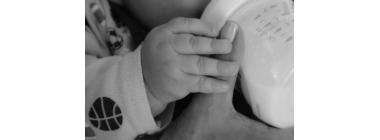.png)
Home Sleep Apnea Tests: What to Expect and How to Prepare
Do you often wake up tired even after sleeping a full night?
You could be snoring so loud that your partner wakes up. Or you nod off during meetings when you should be paying attention. These are all classic signs of sleep apnea.
But here's the real issue…
Traditional sleep studies involve spending the night in a lab with dozens of wires attached to your body. Going to sleep in a hospital setting while a bunch of technicians watch you rest is super unpleasant for most people.
The good news is…
Home sleep testing is a total game-changer. You can now get diagnosed right in the comfort of your own home with easy-to-use portable devices.
And here's the kicker…
Over 32% of American adults have some form of sleep apnea but 80-90% of all cases go undiagnosed. Millions of people suffer needlessly from fatigue and health problems every day. But now, modern medical technology is finally starting to make a difference. Sleep disorders have been neglected for decades but the right level of awareness is finally catching up. Doctors are now recommending home testing as an initial step for many patients. This important shift marks a major change in the world of sleep medicine. It is making a huge difference for patients everywhere looking for a convenient way to get the right diagnosis.
A sleep apnea at home test can diagnose your condition.
What You'll Learn:
-
Everything you need to know about Home Sleep Apnea Testing
-
How accurate are these tests?
-
What equipment will you use?
-
Step-by-step preparation guide
-
Reading your results like a pro
What is a Home Sleep Apnea Test?
Home sleep apnea testing is exactly what it sounds like…
A way to diagnose obstructive sleep apnea without having to sleep at the hospital. The key component is that you wear a small device at night which monitors your breathing, oxygen levels, and heart rate.
Why do they work so well?
Sleep apnea causes very specific, measurable changes in the body. When your airway becomes blocked, your oxygen levels drop, and your heart rate changes. Home sleep apnea tests are excellent at catching these physiological patterns.
How Accurate are Home Sleep Apnea Tests?
"But are home tests accurate enough?"
This is the number one question people have. And it's a completely valid question to ask.
Here's the bottom line:
Home sleep tests have an accuracy rate of anywhere from 68% to 91% depending on the machine used. Accuracy is higher, at over 90%, for those with moderate to severe sleep apnea.
Research has shown that home devices correlate well with lab-based polysomnography. One major study found no significant difference in sleep efficiency between home and lab-based methods.
The take-home message is that, when it comes to screening for suspected obstructive sleep apnea, home tests are highly effective.
What Equipment will I Actually Use?
Most home sleep tests use what doctors call "Type 3" devices. These are portable monitors that track several key measurements.
The following items are found in your typical home sleep test kit:
-
Nasal breathing sensor: Tubes that are placed inside the nostrils to measure airflow
-
Pulse oximeter: Clips that are placed on the finger to track blood oxygen levels
-
Chest band: Goes around the torso to monitor breathing effort
-
Body position sensor: Tracks if the person is sleeping on their back or side
Some newer devices are even more minimal. The WatchPAT system only uses a finger sensor and a chest sensor but still provides 98% accuracy.
Point is these devices are made for average people to use at home.
Your Step-by-Step Preparation Guide
Want the most accurate results? Follow this simple preparation checklist.
The Day Before Your Test
Stick to your regular routine. Don't try to change your sleep schedule or habits for the test.
Avoid caffeine after 2 PM. You don't want that afternoon cup of coffee messing up your normal sleep patterns.
Skip the alcohol completely. One drink can mess with your breathing patterns during sleep.
Setting up for Success
Read the instructions twice. You'd be surprised at how many people rush through the setup and end up missing important steps.
Charge your device fully or insert new batteries. Nothing's worse than having your test fail because the device died at 3 AM.
Set up the equipment 30 minutes before your usual bedtime.
During the Test Night
Sleep in your normal position. Don't force yourself to sleep on your back just because you're wearing the device.
Try to get at least 6 hours of sleep. The test requires enough data to be accurate.
If something goes wrong during the night, don't freak out.
Reading Your Results Like a Pro
After you complete your test, you'll be given a detailed report. The more you understand about what these numbers mean, the better conversation you can have with your doctor.
The Key Numbers to Know
Apnea-Hypopnea Index (AHI): This measures the number of times per hour your breathing is either interrupted or becomes very shallow.
-
Normal: Less than 5 events per hour
-
Mild sleep apnea: 5-14 events per hour
-
Moderate sleep apnea: 15-29 events per hour
-
Severe sleep apnea: 30 or more events per hour
What Your Doctor Will Look For
Sleep doctors don't just look at the AHI number…
They also take into account your symptoms, medical history, and overall health situation. Someone with an AHI of 12 but who feels terrible every day needs treatment.
It's the combination of data and symptoms that determines your final treatment plan.
When You Still Need Lab Testing
Home tests are fantastic, but they aren't perfect for everybody.
You may still need to do an in-lab study if you have:
-
Heart failure or other serious cardiac conditions
-
Suspected central sleep apnea
-
Other sleep disorders besides sleep apnea
-
Chronic lung diseases like COPD
Sometimes, the home device either doesn't get enough data or the results are borderline. In these cases, the more comprehensive lab study provides the needed information.
In-lab polysomnography measures brain waves, eye movements, and muscle activity. This gives the sleep doctors a complete picture.
Think of home testing as a screening test, while the in-lab study is the more comprehensive diagnostic exam.
Making the Most of your Experience
Home sleep testing has totally changed the game when it comes to sleep apnea diagnosis. It is convenient, cost-effective, and highly accurate for people with suspected sleep apnea.
Proper preparation and realistic expectations are key. Home tests work best at detecting moderate to severe sleep apnea in people with classic symptoms.
If your results do show sleep apnea, don't put off treatment. Sleep apnea is linked to heart disease, stroke, and diabetes when left untreated.
Wrapping It All Together
Home sleep apnea tests offer an accessible route to diagnosis for millions of people struggling with undiagnosed sleep problems. Tests provide reliable results without ever having to leave your own bedroom.
For those with suspected obstructive sleep apnea, home testing is often the perfect first step on the path to better sleep and health.
Remember:
The hardest part is getting tested. Once you know what you're dealing with, effective treatments are available to help you sleep better and feel more energetic during the day.
Don't let another night of poor sleep rob you of your best life.








